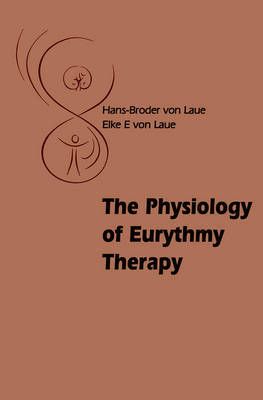
The Physiology of Eurythmy Therapy
- Author: Laue, Elker E. von
- Author: Laue, Hans-Broder von
- Translator: MacGregor, David
Book
$35.25Contents
- 1. Introduction
- 2. The Processes of the Etheric Body Between the Upper and Lower Human Being
- 3. The Polar Effects of Consonants and Vowels 25
- 3. 1 Characterization of the polar effects in the Eurythmy Therapy Course
- 3. 2 Summary
- 3. 3 Further characterization giving the opposite point of view
- 3. 4 Description of the polar effects in subsequent literature
- 3. 5 Attempts to resolve the contradiction
- 4. The Three Elements of Eurythmy
- 4. 1 Rudolf Steiner's first description of movement, feeling and character
- 4.1. 1 Perception of movement, feeling and character
- 4.1. 2 Synaesthetic perceptions of movement, feeling and character
- 4.1. 3 Summary
- 4. 2 Movement, feeling and character in the Eurythmy Therapy Course
- 4. 3 Other descriptions of movement, feeling and character
- 5. Eurythmy Therapy and Other Movement Therapies
- 5. 1 Physiotherapy (therapeutic gymnastics)
- 5. 2 Dance therapy
- 5. 3 Eurythmy therapy between physiotherapy and dance therapy
- 6. The Consonants
- 6. 1 A classification of consonants
- 6. 2 A classification of eurythmy therapy indications for the consonants
- 6.2. 1 Indications for the palate sounds
- 6.2. 2 Indications for the teeth sounds
- 6.2. 3 Indications for the lip sounds
- 6.2. 4 Indications for the middle sounds
- 6. 3 Summary
- 6. 4 The work of blown and impact sounds in the organism
- 7. The Vowels
- 7. 1 Rudolf Steiner's classifications of the vowels
- 7. 2 The relation of speech and eurythmy to the vowels
- 7. 3 A suggested classification of eurythmy therapy indications for the vowels
- 7.3. 1 The I and U exercises
- 7.3. 2 The O and E exercises
- 7.3. 3 The A exercise
- 7.3. 4 The Au and Ei exercises
- 7. 4 Summary
- 8. Vowels and the Upper Human Being; Consonants and the Lower Human Being
- 8. 1 Sounds influencing movements
- 8. 2 Sounds acting on the formation of substances with a specialized function
- 8. 3 Sounds of transformation and individualization of substances
- 8. 4 Sounds for organ-specific substance creation, the diphthongs Au and Ei
- 9. The Soul Exercises
- 9. 1 Exercises with polar feelings
- 9.1. 1 Forming judgments through thinking: affirming -- negating
- 9.1. 2 Agreement through the will: sympathy -- antipathy
- 9. 2 Polar feeling exercises and vowel exercises
- 9.2. 1 Love -- E
- 9.2. 2 Hope -- U
- 9. 3 Laughter -- H-A, Veneration -- A-H
- 10. Transforming Eurythmy into Eurythmy Therapy
- 10. 1 The connection between moving and speaking or listening
- 10. 2 The sequence of the eurythmy therapy exercises
- 10.2. 1 The sequence of the vowel exercises
- 10.2. 2 The swiftness of the consonant exercises
- 10.2. 3 The sequence of the consonant exercises
- 10. 3 The four steps of transformation from eurythmy to eurythmy therapy
- 10.3. 1 Arms and legs
- 10.3. 2 Rapid repetition
- 10.3. 3 Practising and fatigue
- 10.3. 4 Alertness during the movement
- 10.3. 5 Summary
- 10. 4 Processes of the day and the night to be activated in the ether body
- 10. 5 Transformation of movement, feeling and character into eurythmy therapy
- 10.5. 1 Transformation of the movement element
- 10.5. 2 Transformation of the feeling element
- 10.5. 3 Transformation of the character element
- 10.5. 4 In which sequence are the elements experienced?
- 10.5. 5 Summary
- 11. Harmonizing Speaking and Moving
- 11. 1 When does the therapist speak and when does the patient move?
- 11. 2 The danger of speaking while demonstrating eurythmy
- 12. The of Spatial Relationships
- 12. 1 The direction of eurythmy therapeutic movement
- 12. 2 The location of movement and of the effect
- 12.2. 1 Migraine -- B
- 12.2. 2 Irregularities in the abdomen -- M
- 12.2. 3 Ordering the rhythm of breathing and circulation -- R
- 13. Embryological Formative Gestures and their Reflection in Eurythmy Therapy
- 13. 1 The spiritual forces of becoming
- 13.1. 1 The formative forces
- 13.1. 2 The secreting forces
- 13.1. 3 The anchoring or consolidation forces
- 13. 2 The transformation of the forces of becoming into living processes
- 13. 3 The three forces as capacities of soul
- 13. 4 Metamorphosis of the three forces into spiritual capacities
- 13. 5 The three forces and the organism in eurythmy therapy
- 14. Examples of Therapeutic Words
- 14. 1 The cancer sequence O-E-M-L-Ei-B-D
- 14. 2 Chronic constipation, meteorism L-T / D-R
- 14. 3 A child with hemiplegia S-M-A / L-M-Y / T-M-U
- 14. 4 Teething problems in the upper jaw L-A and in the lower jaw L-O
- 14. 5 Motor restlessness -- fidgeting L-U-O-K-M 131
- 14. 6 Dementia R-L-S-I
- 14. 7 Disorder of the liver and intestine, dysphylaxia, cold feet L I -- M A -- R U
- 14. 8 Hypothyroidism S-M-I-A
- 14. 9 Hay fever T-S-R-M-A
- 14. 10 Conclusion
- 15. Future Tasks of Physicians and Eurythmy Therapists
- 15. 1 Movement diagnosis by the eurythmist
- 15. 2 Questions from the eurythmy therapist to the physician
- 15.2. 1 Questions about the diagnosis
- 15.2. 2 The patient's life circumstances and mental state
- 15. 3 Questions from the physician to the eurythmy therapist
- 16. Outline of a Physiology of Eurythmy Therapy
- 17. Epilogue


